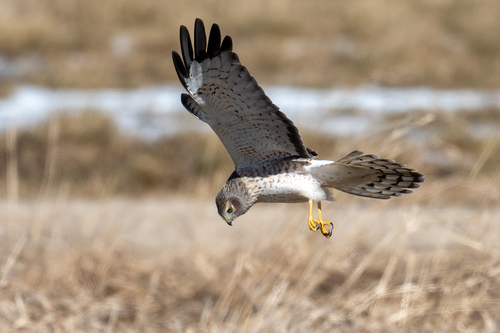
Northern Harrier
The Northern Harrier (*Circus hudsonius*) is a captivating bird of prey known for its distinctive owl-like facial disk and low, coursing flight over open grasslands and marshes. It plays a crucial role in controlling rodent populations, acting as a natural form of pest control. Unlike many raptors that perch high, the Northern Harrier often flies close to the ground, relying on both sight and hearing to locate prey. This species holds a certain mystique, often associated with wide-open spaces and the changing seasons, as many populations undertake significant migrations.
41-52 cm
Length
97-122 cm
Wingspan
Least Concern
Conservation Status
Distribution
The Northern Harrier breeds across North America, from Alaska and Canada south to the northern United States and, in some areas, further south. During winter, they migrate southwards, reaching Central America and the Caribbean. Some populations in the milder western and southern parts of their range may be resident year-round.
Lifespan
Up to 16 years in the wild, although average lifespan is likely shorter. Captive birds can live longer.
Northern Harrier's Habitat
Habitat Types
Grasslands, Marshes, Wet meadows, Agricultural fields (especially fallow fields)
Climate Zones
Temperate, Boreal, Subarctic
Adaptations
Their facial disk, similar to that of owls, helps them to locate prey by sound in dense vegetation. Long legs and sharp talons are adapted for snatching prey from the ground.
Variations
While *Circus hudsonius* is currently recognized as a distinct species, it was previously considered conspecific with the Hen Harrier (*Circus cyaneus*) of Eurasia. Some authorities still debate this taxonomic split.
Appearance
Breeding Plumage
Adult males are gray above and whitish below with black wingtips and a black band on the tail. Adult females are brown above and buffy below with brown streaks. Juveniles resemble females but are generally more rufous.
Seasonal Feather Changes
Plumage does not vary significantly with seasons, although it can become worn and faded before molting.
Sex Based Plumage Differences
Strong sexual dimorphism; males are gray, while females are brown.
Notable Features
Owl-like facial disk, Long, broad wings, Long tail with a white rump patch (visible in flight), Low, coursing flight pattern
Diet and Feeding
Primary Foods
Small mammals (voles, mice, rats), Small birds, Reptiles, Amphibians, Large insects
Foraging Behavior
Hunts by flying low over open ground, using its keen hearing and vision to locate prey. It often hovers briefly before dropping onto its target.
Specializations
The facial disk funnels sound to the ears, enhancing its ability to detect prey hidden in vegetation.
Seasonal Diet Variations
Diet can vary depending on prey availability. During breeding season, they may take more birds, while in winter, they may rely more heavily on rodents.
Behavior
Social Structure
Generally solitary or in pairs during breeding season. May form loose flocks during migration or at winter roosts.
Communication
Vocalizations (whistles, chatters, and wails), Aerial displays (sky-dancing), Visual cues (body posture)
Migration
Many populations are migratory, traveling long distances between breeding and wintering grounds. They often follow coastlines or mountain ranges.
Territorial or Group Behaviors
Males are highly territorial during the breeding season, defending their nesting area from rivals. Outside of breeding, they are less territorial.
Conservation
Threats
Habitat loss (due to agriculture, urbanization, and wetland drainage), Pesticide exposure (through prey), Collisions with vehicles and wind turbines, Climate change (potentially affecting prey availability and migration patterns)
Protection Programs
Habitat restoration and conservation efforts, Monitoring programs to track population trends, Regulations on pesticide use
Local National Laws
Protected under the Migratory Bird Treaty Act in the United States and similar legislation in Canada and Mexico.
Population Trend
Stable
Population Estimates
Global population estimated to be around 500,000 individuals.
Interesting Facts
They are one of the few raptors that rely heavily on hearing to find prey.
Their owl-like facial disk helps them locate prey by sound, even under snow or dense vegetation.
Males and females have distinctly different plumage.
This sexual dimorphism is relatively uncommon among raptors.
They often fly with their wings held in a V-shape.
This dihedral wing posture helps with stability during low, slow flight.
Northern Harriers have been known to drown their prey.
If a captured animal is too large to carry or subdue easily, the harrier may hold it underwater until it drowns.
Faqs about Northern Harrier
What is the difference between a Northern Harrier and a Hen Harrier?
They were once considered the same species, but are now recognized as separate. The Northern Harrier is found in North America, while the Hen Harrier is found in Eurasia. Males are very similar, but females have subtle differences in plumage.
Where can I see a Northern Harrier?
Look for them in open habitats like grasslands, marshes, and agricultural fields. They are often seen flying low over the ground, searching for prey.
Do Northern Harriers mate for life?
They are generally monogamous during a single breeding season, but may choose different partners in subsequent years. Some males may have more than one mate (polygyny).
What do I do if I find an injured Northern Harrier?
Contact a local wildlife rehabilitator or veterinarian. Do not attempt to handle the bird yourself, as they have sharp talons and beaks. *Consult a professional for medical or expert advice.*
Copyright @ Nature Style Limited. All Rights Reserved.
 English
English